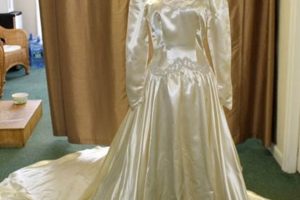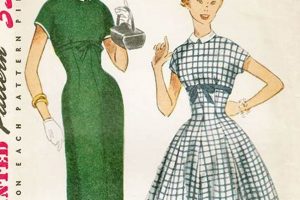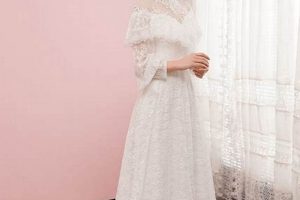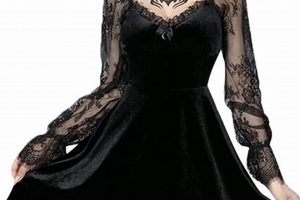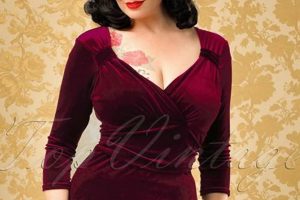Garments produced under the Jessica McClintock label, particularly those from earlier decades, represent a distinct aesthetic within the realm of formal and semi-formal attire. These items often feature romantic design elements such as lace, ruffles, and flowing silhouettes, reflecting a specific era’s fashion sensibilities. A notable example includes Gunne Sax dresses designed by Jessica McClintock, characterized by their prairie-style influence and use of delicate fabrics.
The appeal of these garments lies in their unique combination of historical design and perceived quality. Acquiring such pieces allows individuals to connect with past fashion trends and express personal style through distinctive and often well-constructed clothing. Their enduring popularity also contributes to a circular fashion economy, promoting sustainability by extending the lifespan of existing textiles and reducing the demand for new production.
The following discussion will explore specific characteristics, considerations for acquisition and care, and the enduring influence of these sartorial items on contemporary fashion trends. Topics include dating garments by label variations, assessing condition and authenticity, and incorporating these pieces into modern wardrobes.
The acquisition of garments from the Jessica McClintock line requires careful consideration to ensure authenticity, condition, and suitability. The following guidelines are intended to assist prospective buyers in making informed decisions.
Tip 1: Examine Label Variations: Different iterations of the Jessica McClintock label denote specific production periods. Researching label evolution can assist in dating the garment and verifying its purported age. Consult reputable online resources and vintage fashion guides for accurate label identification.
Tip 2: Assess Fabric Composition: The materials used in these dresses varied over time. Early pieces often featured natural fibers such as cotton and linen, while later designs incorporated synthetic blends. Examining the fiber content and construction provides insight into the garment’s quality and era of origin.
Tip 3: Scrutinize Construction Details: Original garments typically exhibit high-quality construction, including reinforced seams, hand-finished details, and durable closures. Inspect these elements carefully to detect signs of poor workmanship or alterations that may detract from the garment’s value and authenticity.
Tip 4: Evaluate Condition Thoroughly: Pre-owned items may exhibit signs of wear, including stains, tears, and discoloration. Request detailed photographs or, if possible, inspect the garment in person to assess the extent of any damage. Factor in the cost of potential repairs or restoration when determining the garment’s overall value.
Tip 5: Verify Measurements Accurately: Vintage sizing often differs significantly from contemporary standards. Obtain precise measurements of the garment’s bust, waist, and length, and compare them to personal measurements to ensure a proper fit. Allow for potential alterations if necessary.
Tip 6: Inquire About Storage History: Improper storage can negatively impact the condition of delicate fabrics and embellishments. Request information about how the garment was stored prior to acquisition. Evidence of prolonged exposure to sunlight, moisture, or pests may indicate irreversible damage.
Tip 7: Compare Prices and Seller Reputation: Research comparable listings on reputable online marketplaces and consult with experienced vintage clothing dealers to establish a fair market value. Prioritize sellers with positive feedback, transparent return policies, and a proven track record of accurately describing their merchandise.
These considerations serve to mitigate the risks associated with purchasing vintage items and increase the likelihood of acquiring an authentic, well-preserved Jessica McClintock garment that can be enjoyed for years to come.
The subsequent sections will address proper care and preservation techniques to maintain the integrity of these valuable pieces.
1. Romantic Aesthetic
The pervasiveness of a romantic aesthetic within vintage Jessica McClintock designs is not merely stylistic preference but a defining characteristic that fundamentally shapes their appeal and historical significance. The incorporation of elements such as lace, ruffles, flowing silhouettes, and pastel color palettes serves to evoke a sense of idealized femininity and bygone eras. This aesthetic acted as a direct counterpoint to the more austere and practical fashions prevalent in certain periods, offering a refuge in fantasy and elegance. Consider, for instance, the prevalence of Victorian-inspired lace detailing on many of these dresses; this detail directly connects the garments to a specific historical period known for its emphasis on ornamentation and romantic ideals. The effect of this pervasive aesthetic is an enduring perception of these dresses as symbols of special occasions and timeless beauty.
The importance of the romantic aesthetic extends beyond mere visual appeal; it influenced the construction and selection of materials used in creating these garments. For example, the choice of lightweight, flowing fabrics like chiffon and voile enhanced the ethereal quality central to the romantic ideal. The inclusion of features such as empire waistlines or delicate floral embellishments further reinforced this design principle. Analyzing vintage advertisements and fashion editorials from the period reveals the deliberate marketing of these dresses as embodying a romantic ideal, highlighting the importance of this aesthetic in shaping consumer perception and driving sales. The practical application of this understanding allows collectors and enthusiasts to discern authentic vintage pieces and appreciate the intended design principles.
In summary, the romantic aesthetic is not simply an embellishment but an integral component of vintage Jessica McClintock garments. It defines their historical context, influences their construction, and contributes to their enduring appeal. The challenge lies in preserving the integrity of these delicate designs and ensuring that the romantic ideals they embody continue to resonate with contemporary audiences. Understanding this connection allows for a deeper appreciation of these dresses as artifacts of fashion history and embodiments of a particular cultural ideal.
2. Gunne Sax Influence
The association between Gunne Sax and Jessica McClintock designs is undeniable. McClintock initially designed for Gunne Sax before establishing her own eponymous label. Consequently, early Jessica McClintock dresses exhibit design characteristics deeply rooted in the Gunne Sax aesthetic. This influence is manifest in the prevalence of prairie-style silhouettes, the use of calico prints, lace trim, and the incorporation of elements reminiscent of Victorian and Edwardian era fashion. The “Gunne Sax Influence” forms a crucial part of the identity for garments produced during a specific period in Jessica McClintock’s career, marking them as products of a unique confluence of design philosophies. For example, the Gunne Sax-inspired features, such as high necklines and puffed sleeves, distinguished these dresses from more contemporary styles of the time.
This connection has practical implications for collectors and enthusiasts. Recognizing the Gunne Sax influence aids in dating and authenticating these garments. Dresses exhibiting characteristics strongly aligned with the Gunne Sax style are likely to be from the earlier phases of McClintock’s career. Understanding this relationship also enables a more nuanced appreciation of the design elements. The incorporation of antique-inspired detailing, often seen as a hallmark of Gunne Sax, is carried over into McClintock’s early work. Knowing that these garments share a design lineage enriches the appreciation of their aesthetic value. Moreover, it enables the informed assessment of comparable market value; dresses that clearly display Gunne Sax influence are often highly sought after by collectors specializing in this particular style.
In summary, the Gunne Sax influence represents a formative aspect of early Jessica McClintock designs. This connection provides vital clues for authentication, dating, and appreciating the unique design elements present in these dresses. While McClintock eventually developed her own distinct style, the legacy of her time with Gunne Sax remains visible in the romantic, prairie-inspired features found in vintage examples. Understanding this influence allows for a more informed engagement with these garments, enhancing their value and ensuring their preservation.
3. Fabric Composition
The “Fabric Composition” of items produced under the Jessica McClintock label is a pivotal determinant of their durability, aesthetic characteristics, and historical value. Early examples frequently utilized natural fibers, such as cotton, linen, and silk, reflecting the textile production capabilities and fashion trends of the era. These materials offered breathability and a soft hand, aligning with the romantic aesthetic of the garments. A silk dress, for example, would drape more elegantly and possess a richer luster compared to a similar design rendered in a synthetic alternative. The inclusion of these natural materials often signifies a garment’s vintage origin, as subsequent production runs incorporated synthetic blends for cost-effectiveness and ease of care. Therefore, careful analysis of fabric composition can serve as a primary indicator of a garment’s age and authenticity. Conversely, identifying a later dress created with polyester demonstrates an understanding of fabric analysis in distinguishing authentic pieces.
Beyond age determination, fabric composition directly influences the care and preservation requirements of garments. Natural fibers, particularly silk and linen, are susceptible to degradation from sunlight, moisture, and improper cleaning techniques. These materials necessitate specialized care, such as hand washing or professional dry cleaning, to prevent damage and maintain their structural integrity. Garments constructed from synthetic blends, while more durable, may exhibit undesirable characteristics such as static cling and a less luxurious texture. Therefore, prospective buyers must consider the practical implications of fabric composition when evaluating the suitability of a piece and its long-term maintenance needs. The care instructions attached to the garment, if present, provides specific recommendations. For instance, a dress labeled “dry clean only” indicates the presence of delicate fibers that would be damaged by machine washing.
In conclusion, the “Fabric Composition” of garments is inextricably linked to their historical context, aesthetic appeal, and practical considerations. Knowledge of textile properties enables informed decisions regarding acquisition, care, and preservation. Analyzing the fiber content of a Jessica McClintock dress provides valuable insight into its origins, manufacturing processes, and long-term viability, ensuring its continued appreciation as a tangible artifact of fashion history. A continued challenge lies in accurately identifying increasingly complex fiber blends and understanding their specific care requirements, emphasizing the need for ongoing education and resource utilization in the field of vintage garment preservation.
4. Label Chronology
The chronological evolution of garment labels produced by Jessica McClintock provides a crucial tool for dating and authenticating items. Variations in font, design, and brand name placement on the label correlate with specific production periods. Observing these differences enables collectors and historians to place a garment within a defined timeframe, distinguishing genuine vintage pieces from reproductions or contemporary designs bearing superficial similarities. The presence of a “Gunne Sax by Jessica McClintock” label, for example, indicates an earlier creation, reflecting McClintock’s initial design work under the Gunne Sax umbrella, thereby directly connecting label features with historical production contexts. The absence of a care instruction symbol indicates an earlier production year.
The practical significance of understanding label chronology extends to assessing the market value and potential preservation needs of a garment. A dress bearing a label consistent with the early 1970s, for instance, may command a higher price due to its rarity and historical relevance. Furthermore, identifying the production period allows for informed decisions regarding appropriate cleaning and storage methods. Garments from earlier eras often incorporate delicate natural fibers requiring specialized care protocols. Online resources, such as vintage fashion guides and label archives, provide detailed visual references and timelines, empowering collectors and retailers to accurately date and appraise items. This allows for accurate determination if the dress is vintage or retro.
In summary, “Label Chronology” is an indispensable component in evaluating vintage Jessica McClintock garments. Its application facilitates authentication, dating, and informed decision-making regarding acquisition and preservation. The continuous refinement of label designs over time serves as a roadmap, guiding collectors and enthusiasts through the garment’s production history. A persistent challenge involves the accurate documentation and dissemination of label information, necessitating collaborative efforts between historians, collectors, and online platforms to ensure the preservation of this vital resource for future generations.
5. Occasion Wear
The design and marketing of vintage Jessica McClintock dresses were inextricably linked to the concept of occasion wear. These garments were primarily intended for formal events, celebrations, and special moments, shaping their stylistic attributes and contributing to their enduring appeal as collectible items. Understanding this association is crucial for appreciating the historical context and cultural significance of these dresses.
- Formal Events and Celebrations
Vintage Jessica McClintock dresses were frequently marketed towards proms, weddings, and other formal events. The design elements, such as flowing silhouettes, lace embellishments, and delicate fabrics, catered to the desire for elegance and sophistication. Advertisements often depicted young women attending social gatherings, reinforcing the association with celebratory occasions. This strategic positioning contributed significantly to the brand’s success and cemented its place in the fashion landscape of the time.
- Symbolism and Ritual
Dresses designated for special occasions often carry symbolic weight, representing rites of passage, social status, or personal milestones. Vintage Jessica McClintock dresses frequently served as markers of important moments in a young woman’s life, such as graduating from high school or celebrating a significant anniversary. The act of selecting and wearing these dresses involved a degree of ritual, contributing to the emotional value and sentimental attachment associated with the garments. In terms of collectability, this means that there is a higher appreciation for dresses that were preserved specifically because of sentimental or ritual meaning.
- Influence on Design and Materials
The intention for use as “Occasion Wear” impacted the design and selection of materials. More elaborate design and higher quality materials are more likely in garments meant for occasions. The formal nature of the intended events necessitated careful attention to detail and a focus on creating visually striking and memorable pieces. Factors like these would lead to the selection of flowing chiffon, elaborate lace trimming, and intricate beadwork. This focus on high-quality materials and meticulous construction further contributes to the collectibility and enduring appeal of vintage Jessica McClintock dresses.
- Preservation and Collectibility
The association with special occasions often led to careful preservation of garments, further enhancing their value and collectibility. Owners frequently stored these dresses as keepsakes, protecting them from wear and tear. As a result, many vintage Jessica McClintock dresses remain in excellent condition, making them highly desirable to collectors and enthusiasts. The connection to sentimental value and personal memories contributes to their enduring appeal and ensures their continued relevance in contemporary fashion.
In summary, the link between “Occasion Wear” and vintage Jessica McClintock dresses is fundamental to understanding their historical context, stylistic attributes, and enduring appeal. The garments were designed, marketed, and ultimately preserved as symbols of special moments and celebrations, solidifying their place in fashion history and ensuring their continued relevance as collectible items.
Frequently Asked Questions
This section addresses common inquiries regarding garments produced under the Jessica McClintock label, particularly those from earlier decades. The information provided aims to clarify aspects related to identification, care, and valuation.
Question 1: How does one distinguish an authentic vintage Jessica McClintock dress from a reproduction?
Authenticity can be determined through careful examination of label variations, fabric composition, and construction details. Consult reputable vintage fashion guides for label timelines. Assess the fabric content and compare it to materials commonly used during the purported production period. Examine seams, closures, and embellishments for signs of quality workmanship indicative of original designs.
Question 2: What are the primary factors influencing the valuation of a vintage Jessica McClintock dress?
Valuation depends on several key factors, including condition, rarity, design, and provenance. Garments in excellent condition, featuring unique or highly sought-after designs, and with documented provenance generally command higher prices. Market demand and current fashion trends also influence valuation.
Question 3: What are the recommended care procedures for preserving vintage Jessica McClintock dresses?
Care procedures vary depending on the fabric composition. Delicate natural fibers, such as silk and linen, require hand washing or professional dry cleaning. Avoid harsh chemicals, direct sunlight, and prolonged exposure to moisture. Store garments in acid-free tissue paper and breathable garment bags.
Question 4: How does one interpret the sizing labels on vintage Jessica McClintock dresses?
Vintage sizing differs significantly from contemporary standards. Obtain precise measurements of the garment’s bust, waist, and length. Compare these measurements to personal measurements or consult vintage sizing charts to determine the appropriate fit. Consider that alterations may be necessary to achieve a desired fit.
Question 5: What are common issues or flaws encountered when acquiring pre-owned vintage Jessica McClintock dresses?
Common issues include stains, tears, discoloration, and damage to embellishments such as lace or beads. Examine garments thoroughly for signs of wear and tear. Factor in the cost of potential repairs or restoration when assessing the overall value. Mildew odors might be present.
Question 6: Where can one reliably source authentic vintage Jessica McClintock dresses?
Reliable sources include reputable vintage clothing stores, online marketplaces specializing in vintage fashion, and auction houses. Prioritize sellers with positive feedback, transparent return policies, and a proven track record of accurately describing their merchandise. Review all item descriptions and photos carefully.
In summary, acquiring and maintaining garments from the Jessica McClintock line requires informed decision-making. Thorough research and careful attention to detail are essential for ensuring authenticity, preserving value, and enjoying these sartorial items for years to come.
The subsequent section will present specific examples of vintage Jessica McClintock dresses and their defining characteristics.
Conclusion
The preceding exploration of vintage Jessica McClintock dresses has underscored several key aspects. These garments represent a distinct aesthetic period, characterized by romantic design elements and a specific construction style. Factors such as label variations, fabric composition, and the influence of Gunne Sax designs provide essential tools for authentication and dating. Proper care and preservation are crucial for maintaining the value and integrity of these pieces.
The continued appreciation of vintage Jessica McClintock dresses hinges on informed acquisition and responsible stewardship. By adhering to established guidelines and prioritizing preservation efforts, enthusiasts can ensure that these sartorial artifacts remain accessible for future generations, serving as tangible representations of fashion history and cultural trends.


